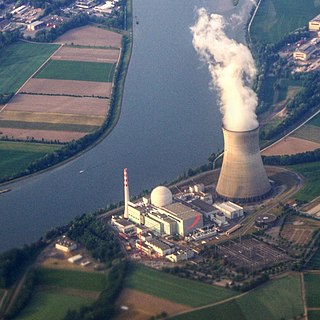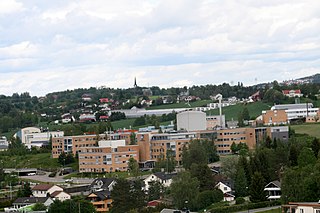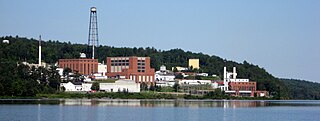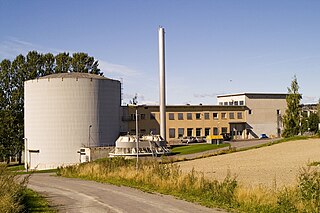Related Research Articles

Nuclear power is the use of nuclear reactions to produce electricity. Nuclear power can be obtained from nuclear fission, nuclear decay and nuclear fusion reactions. Presently, the vast majority of electricity from nuclear power is produced by nuclear fission of uranium and plutonium in nuclear power plants. Nuclear decay processes are used in niche applications such as radioisotope thermoelectric generators in some space probes such as Voyager 2. Generating electricity from fusion power remains the focus of international research.

Kjeller is a village located near Lillestrøm in the municipality of Lillestrøm, Norway. It is located 25 kilometers north-east of Oslo.

Chalk River Laboratories is a Canadian nuclear research facility in Deep River, about 180 km (110 mi) north-west of Ottawa.

Dounreay is a small settlement and the site of two large nuclear establishments on the north coast of Caithness in the Highland area of Scotland. It is on the A836 road nine miles west of Thurso.

The Chernobyl Nuclear Power Plant (ChNPP) is a nuclear power plant undergoing decommissioning. ChNPP is located near the abandoned city of Pripyat in northern Ukraine, 16.5 kilometers (10 mi) northwest of the city of Chernobyl, 16 kilometers (10 mi) from the Belarus–Ukraine border, and about 100 kilometers (62 mi) north of Kyiv. The plant was cooled by an engineered pond, fed by the Pripyat River about 5 kilometers (3 mi) northwest from its juncture with the Dnieper River.

The Argonaut class reactor is a design of small nuclear research reactor. Many have been built throughout the world, over a wide range of power levels. Its functions are to teach nuclear reactor theory, nuclear physics and for use in engineering laboratory experiments.

Research reactors are nuclear fission-based nuclear reactors that serve primarily as a neutron source. They are also called non-power reactors, in contrast to power reactors that are used for electricity production, heat generation, or maritime propulsion.

The water-water energetic reactor (WWER), or VVER is a series of pressurized water reactor designs originally developed in the Soviet Union, and now Russia, by OKB Gidropress. The idea of such a reactor was proposed at the Kurchatov Institute by Savely Moiseevich Feinberg. VVER were originally developed before the 1970s, and have been continually updated. They were one of initial the reactors developed by the USSR, the other being the infamous RBMK. As a result, the name VVER is associated with a wide variety of reactor designs spanning from generation I reactors to modern generation III+ reactor designs. Power output ranges from 70 to 1300 MWe, with designs of up to 1700 MWe in development. The first prototype VVER-210 was built at the Novovoronezh Nuclear Power Plant.
The electricity sector in Sweden has three operational nuclear power plants with 6 operational nuclear reactors, which produce about 29.8% of the country's electricity. The nation's largest power station, Forsmark Nuclear Power Plant, has three reactors producing 3.3 GW and 14% of Sweden's electricity.
As of 2023, Finland has five operating nuclear reactors in two power plants, all located on the shores of the Baltic Sea. Nuclear power provided about 34% of the country's electricity generation in 2020. The first research nuclear reactor in Finland was commissioned in 1962 and the first commercial reactor started operation in 1977. The fifth reactor started operation in April 2023.
Nuclear decommissioning is the process leading to the irreversible complete or partial closure of a nuclear facility, usually a nuclear reactor, with the ultimate aim at termination of the operating licence. The process usually runs according to a decommissioning plan, including the whole or partial dismantling and decontamination of the facility, ideally resulting in restoration of the environment up to greenfield status. The decommissioning plan is fulfilled when the approved end state of the facility has been reached.

Nuclear power construction costs have varied significantly across the world and in time. Large and rapid increases in cost occurred during the 1970s, especially in the United States. Recent cost trends in countries such as Japan and Korea have been very different, including periods of stability and decline in costs.
Atomstroyexport (ASE) JSC (Russian: Атомстройэкспорт) is the Russian Federation's nuclear power equipment and service exporter. It is a fully owned subsidiary of Rosatom.

A neutron research facility is most commonly a big laboratory operating a large-scale neutron source that provides thermal neutrons to a suite of research instruments. The neutron source usually is a research reactor or a spallation source. In some cases, a smaller facility will provide high energy neutrons using existing neutron generator technologies.

Institute for Energy Technology (IFE) was established in 1948 as the Institute for Nuclear Energy (IFA). The name was changed in 1980. Its main office is at Kjeller, Norway, and slightly under half of the institute’s activities are based in Halden. In Halden IFE is host to the international OECD Halden Reactor Project, with 18 member states.
Belgium has two nuclear power plants operating with a net capacity of 5,761 MWe. Electricity consumption in Belgium has increased slowly since 1990 and in 2016 nuclear power provided 51.3%, 41 TWh per year, of the country's electricity.
No nuclear power plant has ever been established in Norway; however, the country has a legal framework for licensing the construction and operation of nuclear installations. Also, four research reactors have been built in Norway. The four reactors were located in Kjeller and Halden and were as follows:

The Halden Reactor was a 25MW (thermal) nuclear reactor located in Halden, Norway and dedicated for research. Construction started 1955 and the reactor became operative in 1958 and was operated by the Institute for Energy Technology (IFE). The reactor was built into bedrock at 100 metres (330 ft) depth. The Halden Reactor was operational 1958–2018.

The Jinshan Nuclear Power Plant or Chin Shan Nuclear Power Plant (金山核能發電廠), First Nuclear Power Plant, is a nuclear power plant being decommissioned in Shimen District, New Taipei, Taiwan. Commissioned in 1978, the plant was Taiwan's first and smallest nuclear power plant.

The Rolls-Royce SMR, also known as the UK SMR, is a small modular reactor (SMR) design being developed by the Rolls-Royce (RR) company in the United Kingdom.
References
- ↑ "Research Reactor Details - JEEP II". IAEA. 2009-03-26. Archived from the original on 2014-08-08. Retrieved 2016-04-25.
- ↑ "Reaktordrift - Forskningsreaktoren JEEP II på Kjeller". www.ife.no. Archived from the original on 2016-04-26. Retrieved 2016-04-25.
- ↑ "JEEP-II research reactor faces uncertain future". WNN - World Nuclear News. 2019-03-13. Retrieved 2021-05-18.
- ↑ "Norges sista kärnreaktor avvecklas". Svenska Dagbladet. TT. 2019-04-25.
- ↑ "Norwegian research reactor to be decommissioned". WNN - World Nuclear News. 2019-04-26. Retrieved 2021-05-18.